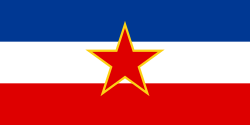History
Proponents of Yugoslav irredentism included both monarchists and republicans. [3] Days prior to Yugoslavia's creation in 1918, Yugoslavist politician Svetozar Pribićević declared that Yugoslavia's borders should extend "from the Soča up to Salonika". [4] Proposals in the interwar period to include Bulgaria within Yugoslavia, included claims by republicans that a republic was necessary for an Integral Yugoslavia with Bulgaria, while others claimed that a republic would not because Bulgaria at that time was a tsardom, and instead claimed that a limited constitutional monarchy would be an appropriate form of state that could include Bulgaria within it. [5] The militant movement Zveno in Bulgaria supported an Integral Yugoslavia that included Bulgaria as well as Albania within it. [6] The Zveno movement participated in the Bulgarian coup d'état of 1934, the coup supporters declared their intention to immediately form an alliance with France and to seek the unification of Bulgaria into an Integral Yugoslavia. [7]
Once World War II began, in 1940 General Milan Nedić proposed that Yugoslavia join the Axis powers and attack Greece to seize Salonika. [8] During World War II, the British government supported the creation of a Greater Yugoslavia after the war due to opposition to the Bulgarian government's accession to the Axis Powers, in May 1941 endorsing Dr. Malcom Burr's paper in favour of the incorporation of Bulgaria into Yugoslavia after the war. [9]
In June 1945, Josip Broz Tito declared that Yugoslavia had the right to have Trieste and all of Carinthia, including Austrian Carinthia, saying "We have liberated Carinthia but international conditions were such that we had to leave it temporarily. Carinthia is ours and we shall fight for it". Neither the Soviet Union nor the Western Allies supported Yugoslav claims against Austria and Italy. Yugoslavia abandoned such claims after the 1948 Tito–Stalin split.
In 1947, Tito and Georgi Dimitrov planned for the eventual annexation of Bulgaria into the Socialist Federal Republic of Yugoslavia, [11] in the Bled agreement, however such arrangements never came to fruition after the Tito-Stalin split, due to Bulgaria siding with the Soviet Union.
This page is based on this
Wikipedia article Text is available under the
CC BY-SA 4.0 license; additional terms may apply.
Images, videos and audio are available under their respective licenses.

